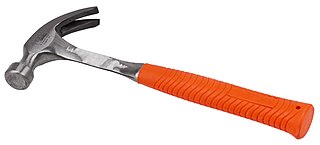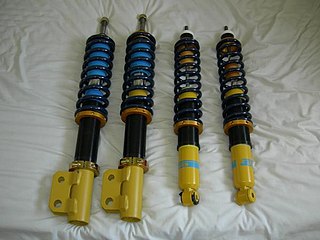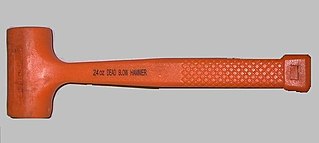
A hammer is a tool consisting of a weighted "head" fixed to a long handle that is swung to deliver an impact to a small area of an object. This can be, for example, to drive nails into wood, to shape metal, or to crush rock. Hammers are used for a wide range of driving, shaping, and breaking applications.

A pump is a device that moves fluids, or sometimes slurries, by mechanical action. Pumps can be classified into three major groups according to the method they use to move the fluid: direct lift, displacement, and gravity pumps.

A player piano is a self-playing piano, containing a pneumatic or electro-mechanical mechanism that operates the piano action via programmed music recorded on perforated paper, or in rare instances, metallic rolls, with more modern implementations using MIDI. The rise of the player piano grew with the rise of the mass-produced piano for the home in the late 19th and early 20th century. Sales peaked in 1924, then declined as the improvement in phonograph recordings due to electrical recording methods developed in the mid-1920s. The advent of electrical amplification in home music reproduction via radio in the same period helped cause their eventual decline in popularity, and the stock market crash of 1929 virtually wiped out production.

A shock absorber or damper is a mechanical or hydraulic device designed to absorb and damp shock impulses. It does this by converting the kinetic energy of the shock into another form of energy which is then dissipated. Most shock absorbers are a form of dashpot.

Recoil is the backward movement of a gun when it is discharged. In technical terms, the recoil momentum acquired by the gun exactly balances the forward momentum of the projectile and exhaust gases (ejecta), according to Newton's third law, known as conservation of momentum. In hand-held small arms, the recoil momentum is transferred to the ground through the body of the shooter, while in heavier guns, such as mounted machine guns or cannons, recoil momentum is transferred to the ground through the mount.

The metacentric height (GM) is a measurement of the initial static stability of a floating body. It is calculated as the distance between the centre of gravity of a ship and its metacentre. A larger metacentric height implies greater initial stability against overturning. The metacentric height also influences the natural period of rolling of a hull, with very large metacentric heights being associated with shorter periods of roll which are uncomfortable for passengers. Hence, a sufficiently, but not excessively, high metacentric height is considered ideal for passenger ships.

A paper machine is an industrial machine which is used in the pulp and paper industry to create paper in large quantities at high speed. Modern paper-making machines are based on the principles of the Fourdrinier Machine, which uses a moving woven mesh to create a continuous paper web by filtering out the fibres held in a paper stock and producing a continuously moving wet mat of fibre. This is dried in the machine to produce a strong paper web.

Laser propulsion is a form of beam-powered propulsion where the energy source is a remote laser system and separate from the reaction mass. This form of propulsion differs from a conventional chemical rocket where both energy and reaction mass come from the solid or liquid propellants carried on board the vehicle.

In automobiles, a double wishbone suspension is an independent suspension design using two wishbone-shaped arms to locate the wheel. Each wishbone or arm has two mounting points to the chassis and one joint at the knuckle. The shock absorber and coil spring mount to the wishbones to control vertical movement. Double wishbone designs allow the engineer to carefully control the motion of the wheel throughout suspension travel, controlling such parameters as camber angle, caster angle, toe pattern, roll center height, scrub radius, scuff and more.

A coilover is an automobile suspension device. The name coilover is an abbreviation of "coil-over shock absorber".

Shot peening is a cold working process used to produce a compressive residual stress layer and modify the mechanical properties of metals and composites. It entails striking a surface with shot with force sufficient to create plastic deformation.

Gas-operation is a system of operation used to provide energy to operate locked breech, autoloading firearms. In gas operation, a portion of high-pressure gas from the cartridge being fired is used to power a mechanism to dispose of the spent case and insert a new cartridge into the chamber. Energy from the gas is harnessed through either a port in the barrel or a trap at the muzzle. This high-pressure gas impinges on a surface such as a piston head to provide motion for unlocking of the action, extraction of the spent case, ejection, cocking of the hammer or striker, chambering of a fresh cartridge, and locking of the action. The first mention of a gas piston, used in a single-shot breech-loading rifle, was by an American by the name of Edward Lindner in 1856, though the idea was patented in Britain. In 1866 an Englishman by the name of William Curtis patented a gas-operated repeating rifle, though it was never built. In 1883-5 in addition to blowback and recoil gas operation was patented by Hiram Maxim.
Hex Combat is a hex-based strategy wargame system by Sabertooth Games and its associated collectible miniatures game (CMG) themed on The Lord of the Rings. Like the popular CMG HeroClix, Hex Combat miniatures are cast in soft plastic and sold pre-painted. They also have statistics printed directly on the base as well as sliders or dials that allow players to keep track of the state of each individual game unit without the need for pencil and paper.

A solenoid valve is an electromechanically operated valve.
Hardness is a measure of the resistance to localized plastic deformation induced by either mechanical indentation or abrasion. Some materials are harder than others. Macroscopic hardness is generally characterized by strong intermolecular bonds, but the behavior of solid materials under force is complex; therefore, there are different measurements of hardness: scratch hardness, indentation hardness, and rebound hardness.

A Schmidt hammer, also known as a Swiss hammer or a rebound hammer or concrete hammer test, is a device to measure the elastic properties or strength of concrete or rock, mainly surface hardness and penetration resistance. It was invented by Ernst Schmidt, a Swiss engineer.

A dead blow hammer is a specialized mallet helpful in minimizing damage to the struck surface and in limiting peak striking force, with minimal elastic rebound from the struck surface. The minimal rebound is helpful in avoiding accidental damage to precision work, especially in tight locations and in applications such as maintenance work on hydraulic cylinders.

An automatic center punch is a hand tool used to produce a dimple in a workpiece. It performs the same function as an ordinary center punch but without the need for a hammer. When pressed against the workpiece, it stores energy in a spring, eventually releasing it as an impulse that drives the punch, producing the dimple. The impulse provided to the point of the punch is quite repeatable, allowing for uniform impressions to be made.

Roll slitting is a shearing operation that cuts a large roll of material into narrower rolls. There are two types of slitting: log slitting and rewind slitting. In log slitting the roll of material is treated as a whole and one or more slices are taken from it without an unrolling/re-reeling process. In rewind slitting the web is unwound and run through the machine, passing through knives or lasers, before being rewound on one or more shafts to form narrower rolls. The multiple narrower strips of material may be known as mults or pancakes if their diameter is much more than their width. For rewind slitting the machine used is called a slitter rewinder, a slitter or a slitting machine – these names are used interchangeably for the same machines. For particularly narrow and thin products, the pancakes become unstable, and then the rewind may be onto a bobbin-wound reel: the rewind bobbins are much wider than the slit width and the web oscillates across the reel as it is rewound. Apart from the stability benefit it is also then possible to put very long lengths,, onto one bobbin.

The Leeb Rebound Hardness Test (LRHT) is one of the four most used methods for testing metal hardness. This portable method is mainly used for testing sufficiently large workpieces.

















